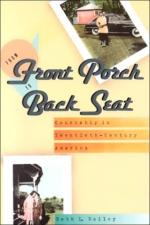
|
| Name: _________________________ | Period: ___________________ |
This test consists of 15 multiple choice questions and 5 short answer questions.
Multiple Choice Questions
1. The protocol for going steady was strict and often involved what, according to the author in Chapter 2, "The Economy of Dating”?
(a) The church’s blessing.
(b) Written vows.
(c) Life and death experiences.
(d) A visible token.
2. What was Beth Bailey defending when she appeared on television during her senior year of college?
(a) Homosexuality.
(b) Polygamy.
(c) Coed dorms.
(d) Communal living.
3. What are shown in the book to be highly variable and responsive to changes in social attitudes and economic developments?
(a) Religious attitudes.
(b) Cultural norms.
(c) Government regulations.
(d) Middle class incomes.
4. Going steady stopped being a guaranteed path to what, according to the author in Chapter 2, "The Economy of Dating”?
(a) Enlightenment.
(b) Financial success.
(c) Marriage.
(d) Having children.
5. What courtship events does the author describe in colleges in Chapter 3, "The Worth of a Date”?
(a) Football games.
(b) Dances.
(c) Graduations.
(d) Exams.
6. On what television show did Beth Bailey appear on when she was a senior in college?
(a) The Ricki Lake Show.
(b) The Phil Donahue Show.
(c) The Geraldo Rivera Show.
(d) The Jerry Springer Show.
7. An incredibly high rate of what appeared after World War II, according to the author in Chapter 2, "The Economy of Dating”?
(a) Separations.
(b) Teenage pregnancy.
(c) Divorces.
(d) Marriages.
8. The new practice of going steady entirely destroyed what system according to the author in Chapter 2, "The Economy of Dating”?
(a) The marriage system.
(b) The dating-rating system.
(c) The courting system.
(d) The call system.
9. What word from Chapter 3, "The Worth of a Date” means to make larger?
(a) Fortify.
(b) Illuminate.
(c) Transform.
(d) Augment.
10. What “special dates” incurred great cost, according to the author in Chapter 3, "The Worth of a Date”?
(a) Graduations.
(b) Fairs.
(c) Proms.
(d) Square dances.
11. Who within the dating system was initially the girl who was in the most demand for dates?
(a) The rich girl.
(b) The smart girl.
(c) The popular girl.
(d) The redheaded girl.
12. According to the author in Chapter 2, "The Economy of Dating,” after returning from World War II, American college men saw their coed women as what?
(a) Loving and humble.
(b) Spoiled and selfish.
(c) Rude and disconnected.
(d) Wholesome and polite.
13. What became more fragile as the fifties and sixties progressed, according to the author?
(a) The middle class.
(b) Gender identities.
(c) International relations.
(d) Law and order.
14. Bailey notes that dating experience was only presented as a national what in the Introduction?
(a) Pastime.
(b) Sport.
(c) Institution.
(d) Phenomenon.
15. Who largely controlled the calling system, according to the author in Chapter 1, "Calling Cards and Money"?
(a) The priest.
(b) The man.
(c) The mayor.
(d) The woman.
Short Answer Questions
1. According to the author in Chapter 1, "Calling Cards and Money,” dating became a system of what?
2. According to the author in Chapter 2, "The Economy of Dating,” dating satisfied a need in a world where few women had what?
3. According to the author in Chapter 2, "The Economy of Dating,” the transition to dating appeared as an accommodation to what?
4. Beth Bailey asserts that contemporary men are objectified as what in Chapter 3, "The Worth of a Date"?
5. Where was Beth Bailey teaching when the book was written?
|
This section contains 508 words (approx. 2 pages at 300 words per page) |

|




